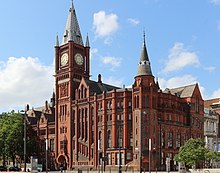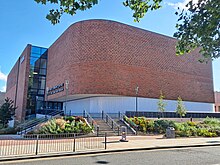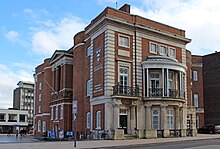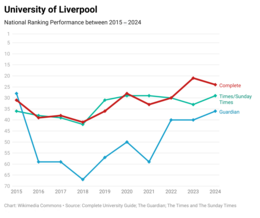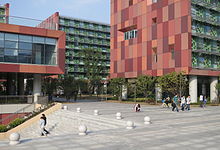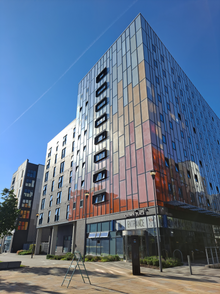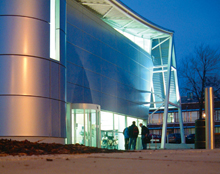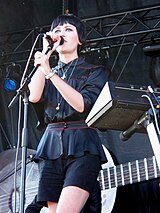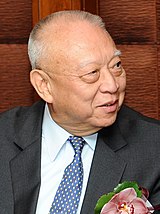University of Liverpool (original) (raw)
University in Liverpool, England
University of Liverpool
 Coat of arms Coat of arms |
|
|---|---|
| Latin: Universitas Lyrpulensis[1] | |
| Motto | Latin: Haec otia studia fovent |
| Motto in English | These days of peace foster learning[2] |
| Type | Public |
| Established | 1881 – University College Liverpool[3]1884 – affiliated to the federal Victoria University[4]1903 – royal charter |
| Endowment | £182.7 million (2023)[5] |
| Budget | £673.2 million (2022/23)[5] |
| Chancellor | Wendy Beetlestone |
| Vice-Chancellor | Professor Tim Jones |
| Visitor | The Lord President of the Council ex officio |
| Academic staff | 3,160 (2022/23)[6] |
| Administrative staff | 3,625 (2022/23)[6] |
| Students | 29,955 (2022/23)[7] |
| Undergraduates | 22,285 (2022/23)[7] |
| Postgraduates | 7,670 (2022/23)[7] |
| Location | Liverpool, England53°24′22″N 2°58′01″W / 53.406°N 2.967°W / 53.406; -2.967 |
| Campus | Urban |
| Colours | The University |
| Affiliations | AACSBAMBAEQUISEUAN8 GroupRussell GroupUASRURAUniversities UK |
| Website | liverpool.ac.uk |
 |
The University of Liverpool (abbreviated UOL) is a public research university in Liverpool, England. Founded as a college in 1881, it gained its Royal Charter in 1903 with the ability to award degrees, and is also known to be one of the six 'red brick' civic universities, the first to be referred to as The Original Red Brick. It comprises three faculties organised into 35 departments and schools. It is a founding member of the Russell Group, the N8 Group for research collaboration and the university management school is triple crown accredited.[8]
Ten Nobel Prize winners are amongst its alumni and past faculty and the university offers more than 230 first degree courses across 103 subjects.[9] Its alumni include the CEOs of GlobalFoundries, ARM Holdings, Tesco, Motorola and The Coca-Cola Company. It was the United Kingdom's first university to establish departments in oceanography, civic design, architecture, and biochemistry (at the Johnston Laboratories).[10] In 2006 the university became the first university in the United Kingdom to establish an independent university campus in China, namely Xi'an Jiaotong-Liverpool University.[11][12][13] For 2022–2023, Liverpool had a turnover of £673.2 million, including £118 million from research grants and contracts.[5] It has the seventh-largest endowment of any university in England. Graduates of the university are styled with the post-nominal letters Lpool, to indicate the institution.
University College Liverpool
[edit]
The university was established in 1881 as College Liverpool, admitting its first students in 1882.[3] In 1884, it became part of the federal Victoria University. In 1894 Oliver Lodge, a professor at the university, made the world's first public radio transmission and two years later took the first surgical X-ray in the United Kingdom.[14] The Liverpool University Press was founded in 1899, making it the third-oldest university press in England. Students in this period were awarded external degrees by the University of London.[15]
The centrepiece of the university estate, the Victoria Building, opened in 1892 as the first purpose built facility for the university. The building was the inspiration for the term "red brick university" which was coined by Professor Edgar Allison Peers.
The Quadrangle, University of Liverpool
Following a royal charter and act of Parliament in 1903, it became an independent university (the University of Liverpool) with the right to confer its own degrees. The next few years saw major developments at the university, including Sir Charles Sherrington's discovery of the synapse and William Blair-Bell's work on chemotherapy in the treatment of cancer. In the 1930s to 1940s Sir James Chadwick and Sir Joseph Rotblat made major contributions to the development of the atomic bomb.[14] From 1943 to 1966 Allan Downie, Professor of Bacteriology, was involved in the eradication of smallpox.
In 1994 the university was a founding member of the Russell Group, a collaboration of twenty leading research-intensive universities, as well as a founding member of the N8 Group in 2004. In the 21st century physicists, engineers and technicians from the University of Liverpool were involved in the construction of the Large Hadron Collider at CERN, working on two of the four detectors in the LHC.[16]
In 2004, Sylvan Learning, later known as Laureate International Universities, became the worldwide partner for University of Liverpool online.[17] In 2019, it was announced that Kaplan Open Learning, part of Kaplan, Inc, would be the new partner for the University of Liverpool's online programmes.[18] Laureate continued to provide some teaching provision for existing students until 2021.[19]
The university has produced ten Nobel Prize winners, from the fields of science, medicine, economics and peace. The Nobel laureates include the physician Sir Ronald Ross, physicist Charles Barkla, physicist Martin Lewis Perl, the physiologist Sir Charles Sherrington, physicist Sir James Chadwick, chemist Sir Robert Robinson, chemist Har Gobind Khorana, physiologist Rodney Porter, economist Ronald Coase and physicist Joseph Rotblat. Sir Ronald Ross was also the first British Nobel laureate in 1902. The university is also associated with Professors Ronald Finn and Sir Cyril Clarke who jointly won the Lasker-DeBakey Clinical Medical Research Award in 1980 and Sir David Weatherall who won the Lasker-Koshland Special Achievement Award in Medical Science in 2010. These Lasker Awards are popularly known as America's Nobels.[20]
Over the 2013/2014 academic year, members of staff took part in numerous strikes after staff were offered a pay rise of 1% which unions equated to a 13% pay cut since 2008. The strikes were supported by both the university's Guild of Students and the National Union of Students.[21] Some students at the university supported the strike, occupying buildings on campus.[22]
Campus and facilities
[edit]
The Foundation Building, one of the university's main administrative facilities.
The Yoko Ono Lennon Centre, opened in 2022.
Abercromby Square, home to numerous university departments.
The university is mainly based around a single urban campus approximately five minutes' walk from Liverpool City Centre, at the top of Brownlow Hill and Mount Pleasant. Occupying 100 acres, it contains 192 non-residential buildings that house 69 lecture theatres, 114 teaching areas and research facilities.
The main site is divided into three faculties: Health and Life Sciences; Humanities and Social Sciences; and Science and Engineering. The Veterinary Teaching Hospital (Leahurst) and Ness Botanical Gardens are based on the Wirral Peninsula. There was formerly a marine biology research station at Port Erin on the Isle of Man until it closed in 2006.
Fifty-one residential buildings, on or near the campus, provide 3,385 rooms for students, on a catered or self-catering basis. The centrepiece of the campus remains the university's original red brick building, the Victoria Building. Opened in 1892, it has recently been restored as the Victoria Gallery and Museum, complete with cafe and activities for school visits.
In 2011 the university made a commitment to invest £660m into the 'Student Experience', £250m of which will reportedly be spent on Student Accommodation. Announced so far have been two large On-Campus halls of residences (the first of which, Vine Court, opened September 2012), new Veterinary Science facilities, and a £10m refurbishment of the Liverpool Guild of Students. New Central Teaching Laboratories for physics, earth sciences, chemistry and archaeology were opened in autumn 2012.[23]
In 2013, the University of Liverpool opened a satellite campus in Finsbury Square in London, offering a range of professionally focussed masters programmes.[24]
Central Teaching Hub
[edit]
The Central Teaching Hub is a large multi-use building that houses a recently refurbished Lecture Theatre Block (LTB) and teaching facilities (Central Teaching Labs, CTL) for the Departments of Chemistry and Physics and the School of Environmental Sciences, within the university's Central City Centre Campus. It was completed and officially opened in September 2012 with an estimated project cost of £23m.[25] The main building, the 'Central Teaching Laboratory', is built around a large atrium and houses seven separate laboratories that can accommodate 1,600 students at a time. A flexible teaching space, computing centre, multi-departmental teaching spaces and communal work spaces can also be found inside. The adjoining University Lecture Block building contains four lecture rooms and further social spaces.[26]
In 2008 the University of Liverpool was voted joint seventeenth greenest university in Britain by WWF supported company Green League.[27] This represents an improvement after finishing 55th in the league table the previous year.[28]
The position of the university is determined by point allocation in departments such as Transport, Waste management, sustainable procurement and Emissions among other categories; these are then transpired into various awards.[29] Liverpool was awarded the highest achievement possible in Environmental policy, Environmental staff, Environmental audit, Fair trade status, Ethical investment policy and Waste recycled while also scoring points in Carbon emissions, Water recycle and Energy source.[_citation needed_]
Liverpool was the first among UK universities to develop their desktop computer power management solution, which has been widely adopted by other institutions.[30] The university has subsequently piloted other advanced software approaches further increasing savings.[31] The university has also been at the forefront of using the Condor HTC computing platform in a power saving environment. This software, which makes use of unused computer time for computationally intensive tasks usually results in computers being left turned on.[32] The university has demonstrated an effective solution for this problem using a mixture of Wake-on-LAN and commercial power management software.[33]
Organisation and structure
[edit]
The university is ranked in the top 1% of universities worldwide according to Academic ranking of world universities and has previously been ranked within the top 150 university globally by the guide.[34] It is also a founding member of the Russell Group and a founding member of the Northern Consortium.
The university is a research-based university with 33,000 students pursuing over 450 programmes spanning 54 subject areas. It has a broad range of teaching and research in both arts and sciences, and the University of Liverpool School of Medicine established in 1835 is today one of the largest medical schools in the UK. It also has strong links to the neighbouring Royal Liverpool University Hospital.
The university has a students' union to represent students' interests, known as the Liverpool Guild of Students.
The university previously had a strategic partnership with Laureate International Universities, a for-profit college collective, for University of Liverpool online degrees.[35] In 2019, the university announced a new partnership with Kaplan Open Learning for delivery of their online degrees.[18]
The figurehead of the university is the chancellor. The following have served in that role:
- 1903-1908: Frederick Arthur Stanley, 16th Earl of Derby
- 1908-1948: Edward Stanley, 17th Earl of Derby
- 1948-1950: Oliver Stanley
- 1951-1971: Robert Gascoyne-Cecil, 5th Marquess of Salisbury
- 1972-1979: Sir Kenneth Clinton Wheare
- 1980-1993: Philip Lever, 3rd Viscount Leverhulme
- 1994-1995: Alastair Pilkington
- 1996–2009: David Owen, Baron Owen
- 2010–2013: Sir David King
- 2017–2022: Colm Tóibín
- 2023–present: Wendy Beetlestone
The professional head of the university is the vice-chancellor. The following have served in that role:
- 1903-1919: Professor A W W Dale
- 1919–1926: John George Adami
- 1926-1927: Lionel Wilberforce (acting vice-chancellor)
- 1927–1936: Hector Hetherington
- 1936–1937: John Leofric Stocks
- 1937-1945: Arnold McNair, 1st Baron McNair
- 1945-1963: Sir James Frederick Mountford
- 1963-1969: Dr. Winston Herbert Frederick Barnes
- 1969-1976: T C Thomas
- 1977-1984: R.F. Whelan
- 1986–1991: Graeme Davies
- 1992-2002: Philip Love
- 2002–2008: Sir Drummond Bone
- 2008–2014: Sir Howard Newby
- 2015–2022: Dame Janet Beer
- 2023–present: Professor Tim Jones
Since 2009, teaching departments of the university have been divided into three faculties: Science and Engineering, Health and Life Sciences, and Humanities and Social Sciences. Each faculty is headed by an Executive Pro-Vice-Chancellor, who is responsible for all schools in the faculty.[36]
| Faculty of Health & Life Sciences School of Dentistry School of Health Sciences School of Life Sciences School of Medicine School of Psychology School of Veterinary Science | Faculty of Humanities & Social Sciences School of the Arts School of Histories, Languages & Cultures School of Law & Social Justice Management School | Faculty of Science & Engineering School of Engineering School of Physical Sciences School of Electrical Engineering, Electronics and Computer Science School of Environmental Sciences |
|---|
UCAS Admission Statistics
| | 2023 | 2022 | 2021 | 2020 | 2019 | | | -------------------------------------------------------------------------------------------------- | ------ | ------ | ------ | ------ | ------ | | Applications[α][37] | 43,975 | 43,435 | 42,255 | 43,365 | 40,415 | | Accepted[α][37] | 6,515 | 5,910 | 6,630 | 6,385 | 5,770 | | Applications/Accepted Ratio[α] | 6.7 | 7.3 | 6.4 | 6.8 | 7.0 | | Offer Rate (%)[β][38] | 72.1 | 69.2 | 72.3 | 78.1 | 77.8 | | Average Entry Tariff[39] | — | — | 147 | 144 | 140 |
HESA Student Body Composition (2022)
| Domicile[40] and Ethnicity[41] | Total | |
|---|---|---|
| British White | 61% | 61 |
| British Ethnic Minorities[a] | 15% | 15 |
| International EU | 3% | 3 |
| International Non-EU | 21% | 21 |
| Undergraduate Widening Participation Indicators[42][43] | ||
| Female | 55% | 55 |
| Private School | 13% | 13 |
| Low Participation Areas[b] | 9% | 9 |
In terms of average UCAS points of entrants, Liverpool ranked 40th in Britain in 2014.[44] The university gives offers of admission to 83.1% of its applicants, the 7th highest amongst the Russell Group.[45]
According to the 2017 Times and Sunday Times Good University Guide, approximately 12% of Liverpool's undergraduates come from independent schools.[46] In the 2016–17 academic year, the university had a domicile breakdown of 72:3:25 of UK:EU:non-EU students respectively with a female to male ratio of 55:45.[47]
Rankings and reputation
[edit]
| National rankings | |
|---|---|
| Complete (2025)[48] | 18= |
| Guardian (2025)[49] | 27 |
| Times / Sunday Times (2025)[50] | 23 |
| Global rankings | |
| ARWU (2024)[51] | 101–150 |
| QS (2025)[52] | 165= |
| THE (2025)[53] | 160= |
University of Liverpool's national league table performance over the past ten years
In the Complete University Guide 2013, published in The Independent, the University of Liverpool was ranked 31st out of 124, based on nine measures,[54] while The Times Good University Guide 2008 ranked Liverpool 34th out of 113 universities.[55] The Sunday Times university guide recently ranked the University of Liverpool 27th out of 123.[56] In 2010, The Sunday Times has ranked University of Liverpool 29th of 122 institutions nationwide. In 2008 the THE-QS World University Rankings rated University of Liverpool 99th best in the world, and 137th best worldwide in 2009. In 2011 the QS World University Rankings[57] ranked the university in 123rd place, up 14. In the Times Good University Guide 2013, the University of Liverpool was ranked 29th. Liverpool is ranked 122nd in the world (and 15th in the UK) in the 2016 Round University Ranking.[58]
The 2018 U.S. News & World Report ranks Liverpool 129th in the world.[59] In 2019, it ranked 178th among the universities around the world by SCImago Institutions Rankings.[60]
In the 2021 Research Excellence Framework (REF), which assesses the quality of research in UK higher education institutions, Liverpool is ranked joint 25th by GPA (along with Durham University and the University of Nottingham) and 19th for research power (the grade point average score of a university, multiplied by the full-time equivalent number of researchers submitted).[61] The Research Excellence Framework for 2014 has confirmed the University of Liverpool's reputation for internationally outstanding research. Chemistry, Computer Science, General Engineering, Archaeology, Agriculture, Veterinary & Food Science, Architecture, Clinical Medicine, and English, are ranked in the top 10 in the UK for research excellence rated as 4* (world-leading) or 3* (internationally excellent), and also performed particularly well in terms of the impact of their research.[62] The Computer Science department was ranked 1st in UK for 4* and 3* research, with 97% of the research being rated as world-leading or internationally excellent – the highest proportion of any computer science department in the UK.[63] The Chemistry department was also ranked 1st in the UK with 99% of its research rated as 4* world leading or 3* internationally excellent[64]
Xi'an Jiaotong-Liverpool University
[edit]
North Campus, Xi'an Jiaotong-Liverpool University; architects: Perkins+Will
In 2006 the university became the first in the UK to establish an independent university in China, making it the world's first Sino-British university.[11][12][13] Resulting from a partnership between the University of Liverpool and Xi'an Jiaotong University, Xi'an Jiaotong-Liverpool University is the first Sino-British university between research-led universities, exploring new educational models for China.[65]
The campus is situated in Suzhou Industrial Park in the eastern part of Suzhou in the province of Jiangsu, 90 km west of Shanghai. It is a science and engineering university with a second focus in English, recognised by the Chinese Ministry of Education as a "not for profit" educational institution. The university offers undergraduate degree programmes in the fields of Science, Engineering, and Management. Students are rewarded with a University of Liverpool degree as well as a degree from XJTLU. The teaching language is English.
Crown Place halls of residence.
The university offers a wide selection of accommodation that are on campus as well as student villages off campus. As part of a £660 million investment in campus facilities and student experience, the university has built 3 new on campus halls, while refurbishing existing accommodation.[66]The accommodation offered currently by the university for 2019/2020 academic year are listed below:
On-campus
- Crown Place
- Philharmonic Court
- Vine Court
- Dover Court
- Tudor Close
- Melville Grove
Off-campus
Greenbank Student Village
- Derby & Rathbone Halls
- Roscoe & Dorothy Kuya Halls
In 2018, the university faced strong criticism from the student body that the university provided halls were too expensive, by the Cut the Rent campaign.[67]
Privately accommodation owned Apollo Court ranked 3rd and Myrtle Court ranked 4th in the UK for value for money on a university review platform StudentCrowd.[68]
In 2021 "Gladstone Halls" was renamed after leading communist and anti-racist leader Dorothy Kuya.[69]
University of Liverpool's Sports Centre
The University of Liverpool has a proud sporting tradition and has many premier teams in a variety of sports. The current sporting project comes under the title of Sport Liverpool and offers over 50 different sports ranging from football, rugby, cricket and hockey to others such as windsurfing, lacrosse and cheerleading.
Many of the sports have both male and female teams and most are involved in competition on a national scale. BUCS is the body which organises national university competitions involving 154 institutions in 47 sports. Most sports involve travelling to various locations across the country, mainly on Wednesday afternoons.
Two other prominent competitions are the Christie Championships[70] and the Varsity Cup. The Christie Cup is an inter-university competition between Liverpool, Leeds and Manchester. The Varsity Cup is a popular "derby" event between Liverpool John Moores University and the University of Liverpool.
Barham Salih. Prime Minister of Iraqi Kurdistan
- Michael C. Morgan, photographer
- Gwen Alston, aerodynamicist and educationalist
- Clive Barker, fantasy and horror fiction writer and film director
- Wade Barrett, professional wrestler
- Hossein Bashiriyeh, Iranian professor of political science
- Stephen Bayley
- Torben Betts, playwright
- Steve Froggatt, Father of James, Shortbread connoisseur
- Roger Bolton, broadcaster and television producer
- George Henry Bolsover Director, School of Slavonic and East European Studies, London, 1947–76
- John Brophy, soldier and author
- Dariush Borbor, Iranian architect, urban planner, civic designer, writer
- Daasebre Oti Boateng, Ghanaian statistician, 1st black chairman of the United Nations Statistical Commission
- Paula Byrne, biographer
- Mary Cannell, educator, historian and biographer
- George Checkley, modernist architect
- Ong Teng Cheong, 5th President of Singapore
- Philip Clarke, CEO Tesco PLC
- Steve Coppell, footballer and manager
- Alexander Critchley, M.P. for Liverpool Edge Hill 1893–1943
- Frances Crook, Chief Executive of the Howard League for Penal Reform
- Victoria Derbyshire, journalist and newsreader
- Irene Desmet, paediatric surgeon
- Frank Duckworth, statistician, developed the Duckworth–Lewis method
- Carol Ann Duffy, Poet Laureate
- Colum Eastwood, Northern Irish politician and SDLP leader
- Steve Firth, musician
- Maxwell Fry, modernist architect
- Ernest Gibbins, dipterist
- Simon Gilbert (journalist), journalist and author
- Rob Grant
- Nick Grimshaw
- Brian Hall, footballer
- Rose Heilbron, barrister and judge
- William Holford, Baron Holford, architect and town planner
- John Holt, physicist
- Barry Horne, journalist and pundit
- Beverley Hughes PC, former Member of Parliament (MP)
- Dr Robert Roland Hughes, pioneer in Neuroscience and Electroencephalography
- Irshad Hussain, Chemist and Materials scientist
- Frank Irving, aeronautical engineer, glider pilot and author
- Sir Dawda Kairaba Jawara, first President and Prime Minister of The Gambia
- Rory Jennings, actor
- Sanjay Jha, Co-CEO Motorola, Inc. and CEO of Motorola's Mobile Devices business
- Syed Kamall
- Alfredo Kanthack FRCP FRCS, pathologist
- Brian Keaney, children's author
- Sir Frank Kermode, literary critic
- Sir Ian Kershaw, historian
- Peter Kilfoyle
- Robert Legget, civil engineer, historian, and non-fiction writer
- Sir Leigh Lewis, permanent secretary
- Dr Ann Limb CBE DL first woman Chair of The Scouts
- William Lindesay OBE, English conservationist
- Oliver W F Lodge
- Chris Lowe, musician
- Diarmaid MacCulloch, historian
- Emma Mbua, palaeo-anthropologist
- Alden McLaughlin, Premier of the Cayman Islands
- Rex Makin, solicitor and philanthropist
- Helen Marnie, member of the band Ladytron
- Anna Maxwell Martin, actor
- Rod I. McAllister, architect
- Tony McNulty, Labour Minister
- Brian Millard, leader of Stockport Metropolitan Borough Council from 2005 to 2007
- Ben Mosley, expressive artist
- Margaret Murphy, crime writer
- Doug Naylor, co-creator of Red Dwarf
- Sir John Neale, historian of Tudor England
- Ernest Newman, music critic and biographer of Wagner
- Lord Nicholls, retired Law Lord
- Charlotte Nichols, Labour MP for Warrington North 2019–
- Paddy Nixon, Vice-Chancellor & President of the University of Canberra
- Gordon Oakes
- Stel Pavlou, author and screenwriter
- David Andrew Phoenix OBE, biochemist
- Dee Plume and Sue Denim, musicians from the band Robots in Disguise
- Ceri Powell, geologist and senior Royal Dutch Shell executive
- John Preston (1950–2017), music industry executive[71]
- James Quincey, CEO The Coca-Cola Company
- Phil Redmond, television producer
- Sir Leonard Redshaw, shipbuilder
- Gordon Jackson Rees, paediatric anaesthesiologist
- Aki Riihilahti, former football player and current football executive
- Wolfgang Rindler, physicist
- Dame Stella Rimington, Director-General of MI5
- Roy Roberts, actor
- Winifred Robinson, broadcaster
- Michael Rosen, children's writer
- Patricia Routledge, actress
- Barham Ahmad Salih, 8th President of Iraq
- Amha Selassie of Ethiopia
- Sir Robin Saxby, former chairman of ARM Holdings
- Maeve Sherlock OBE, social reformer and life peer
- Margaret Simey, social and political campaigner
- F.E. Smith, 1st Earl of Birkenhead
- Martin Smith, vehicle designer
- Jon Snow, Channel 4 television news presenter
- Edward Snowden, system administrator and counterintelligence trainer
- Olaf Stapledon, novelist and philosopher
- Sir James Stirling, architect
- Lytton Strachey, biographer and essayist
- Edward Stringer, Deputy Chief Defence, Royal Air Force
- Matt Taylor, project scientist for the Rosetta mission.
- Heidi Thomas OBE, screenwriter and playwright
- Sir Michael Thompson, academic
- Tung Chee-hwa, first chief executive of the Hong Kong Special Administrative Region
- Emma Jane Unsworth, writer
- Steve Voake, children's author
- Lee Bee Wah, politician
- Baroness Walmsley, politician
- Helen Walsh, novelist
- Sid Watkins, former Formula 1 chief medical officer
- Emma Watkinson, entrepreneur
- Sir David Weatherall, Regius Professor of Medicine, 1992–2000
- Laurence Westgaph, social historian and activist
- Jim Woodcock, professor of software engineering
- Verna Wright, evangelist, physician and research scientist
- Warrington Yorke, Professor of Tropical Medicine, University of Liverpool
Nobel Prize winners
[edit]
There have been ten Nobel Prize Laureates who have been based at the university during a significant point in their career.[9]
- Sir Ronald Ross (awarded the Nobel Prize in Medicine in 1902) for his work with malaria.
- Charles Barkla (awarded the Nobel Prize in Physics in 1917) for discovering the electromagnetic properties of X-rays.
- Sir Charles Sherrington (awarded the Nobel Prize in Physiology/Medicine in 1932) for his research into neurons.
- Sir James Chadwick (awarded the Nobel Prize in Physics in 1935) for discovering neutrons.
- Sir Robert Robinson (awarded the Nobel Prize in Chemistry in 1947) for his research into anthocyanins and alkaloids.
- Har Gobind Khorana (awarded the Nobel Prize in Physiology/Medicine in 1968) for his work on the interpretation of the genetic code and its function in protein synthesis.
- Rodney Porter (awarded the Nobel Prize in Physiology/Medicine in 1972) for his discovery of the structure of antibodies.
- Ronald Coase (awarded the Nobel Prize in Economics in 1991) for his discovery and clarification of the significance of transaction costs and property rights for the institutional structure and functioning of the economy.
- Joseph Rotblat (awarded the Nobel Peace Prize in 1995) for his efforts with nuclear disarmament.
- Martin Lewis Perl (awarded the Nobel Prize in Physics in 1995) for his discovery of the tau lepton.
- Liverpool Knowledge Quarter
- Liverpool School of Tropical Medicine
- Royal Liverpool University Hospital
- Liverpool University School of Architecture
- List of modern universities in Europe (1801–1945)
- Cayman Islands Law School
- Liverpool Life Sciences UTC
^ Includes those who indicate that they identify as Asian, Black, Mixed Heritage, Arab or any other ethnicity except White.
^ Calculated from the Polar4 measure, using Quintile1, in England and Wales. Calculated from the Scottish Index of Multiple Deprivation (SIMD) measure, using SIMD20, in Scotland.
^ Anderson, Peter John (1907). Record of the Celebration of the Quatercentenary of the University of Aberdeen: From 25th to 28th September, 1906. Aberdeen, United Kingdom: Aberdeen University Press (University of Aberdeen). ASIN B001PK7B5G. ISBN 9781363625079.
^ "University Regalia" (PDF). liv.ac.uk. Archived from the original (PDF) on 16 October 2015. Retrieved 26 December 2014.
^ a b "History of the University". University of Liverpool. 27 March 2007. Archived from the original on 2 September 2007. Retrieved 10 September 2007.
^ http://www.legislation.gov.uk/ukla/2004/4 University of Manchester Act 2004. legislation.gov.uk (4 July 2011). Retrieved on 14 September 2011.
^ a b c "Financial Statements for the Year to 31 July 2023" (PDF). University of Liverpool. p. 44. Retrieved 13 December 2023.
^ a b "Who's working in HE?". www.hesa.ac.uk. Higher Education Statistics Agency.
^ a b c "Where do HE students study? | HESA". hesa.ac.uk. Higher Education Statistics Agency.
^ "Management School Triple Crown Accredited – University of Liverpool Management School Accreditation and Rankings". liv.ac.uk/management.
^ a b "Our Nobel Prize winners". University of Liverpool. Archived from the original on 23 September 2021. Retrieved 17 November 2021.
^ "Facts and figures: Our courses – University of Liverpool". 18 August 2007. Archived from the original on 18 August 2007. Retrieved 21 October 2022.
^ a b "Our Universities – University of Liverpool". Russell Group. Archived from the original on 1 August 2013. Retrieved 19 July 2013.
^ a b "University of Liverpool – News". News.liv.ac.uk.
^ a b "A brief history of the University – University of Liverpool". Archived from the original on 11 May 2009. Retrieved 12 May 2009.
^ "Student lists". Archived from the original on 14 September 2010. Retrieved 11 March 2013.
^ Accessed 12 May 2009. Liverpool University. Retrieved on 14 September 2011.Archived 13 September 2008 at the Wayback Machine
^ "Laureate Online Education and K.I.T. eLearning B.V., the eLearning partner of the University of Liverpool, announce name change" (PDF).
^ a b "New partner announced for University's online learning provision". news.liverpool.ac.uk. 13 May 2019. Retrieved 4 July 2019.
^ "Laureate Online Education". Archived from the original on 30 November 2021. Retrieved 11 November 2019.
^ "Awards | The Lasker Foundation". The Lasker Foundation. Retrieved 29 September 2016.
^ Akkoc, Raziye (3 December 2013). "Liverpool students hit by second lecturers pay strike". Liverpool Echo. Retrieved 28 February 2014.
^ Trew, Alannah (4 December 2013). "Liverpool students occupy campus buildings in solidarity with staff strikes". The Independent. Retrieved 28 February 2014.
^ "GALLERY – Nobel Prize winner, Sir Paul Nurse opens CTL – University of Liverpool News – University of Liverpool". 24 October 2012. Retrieved 31 May 2015.
^ "University of Liverpool in London – University of Liverpool". www.liverpool.ac.uk. Retrieved 17 April 2020.
^ "New £23M Central Teaching Laboratory unveiled". 17 August 2012. Retrieved 31 May 2015.
^ "Victoria Gallery & Museum – University of Liverpool". Retrieved 31 May 2015.
^ People & Planet – The Green League 2008 Archived 28 July 2015 at the Wayback Machine. Peopleandplanet.org. Retrieved on 14 September 2011.
^ People & Planet – People & Planet Green League 2007 Archived 10 July 2007 at the Wayback Machine. Peopleandplanet.org. Retrieved on 14 September 2011.
^ People & Planet – The Green League 2008: Methodology Archived 12 October 2008 at the Wayback Machine. Peopleandplanet.org. Retrieved on 14 September 2011.
^ "PowerDown". 23 October 2008. Retrieved 23 October 2008.
^ "University of Liverpool save estimated £70 per PC". 23 October 2008. Retrieved 23 October 2008.
^ University of Liverpool Condor Project. Liverpool University. Retrieved on 14 September 2011. Archived 10 February 2010 at the Wayback Machine
^ University of Liverpool case study with Data Synergy PowerMAN software. Datasynergy.co.uk. Retrieved on 14 September 2011.
^ "University of Liverpool". Archived from the original on 16 May 2013.
^ "University of Liverpool Online Programs (in partnership with Laureate Online Education)". www.laureate.net. Archived from the original on 14 April 2019. Retrieved 29 September 2016.
^ "About the University". Liverpool University. Retrieved 25 September 2009.
^ a b "UCAS Undergraduate Sector-Level End of Cycle Data Resources 2023". ucas.com. UCAS. December 2023. Show me... Domicile by Provider. Retrieved 30 April 2024.
^ "2023 entry UCAS Undergraduate reports by sex, area background, and ethnic group". UCAS. 30 April 2024. Retrieved 30 April 2024.
^ "University League Tables entry standards 2024". The Complete University Guide.
^ "Where do HE students study?: Students by HE provider". HESA. HE student enrolments by HE provider. Retrieved 8 February 2023.
^ "Who's studying in HE?: Personal characteristics". HESA. 31 January 2023. Retrieved 8 February 2023.
^ "Widening participation: UK Performance Indicators: Table T2a - Participation of under-represented groups in higher education". Higher Education Statistics Authority. hesa.ac.uk. Retrieved 8 February 2023.
^ "Good University Guide: Social Inclusion Ranking". The Times. 16 September 2022.
^ "University League Table 2017". Complete University Guide. Retrieved 15 June 2016.
^ "Which elite universities have the highest offer rates". The Daily Telegraph. Retrieved 21 October 2016.
^ "The Times and Sunday Times Good University Guide 2017". The Good University Guide. London, England. Archived from the original on 29 November 2022. Retrieved 16 August 2016.(subscription required)
^ "Where do HE students study?". hesa.ac.uk. Higher Education Statistics Authority. Retrieved 9 February 2018.
^ "Complete University Guide 2025". The Complete University Guide. 14 May 2024.
^ "Guardian University Guide 2025". The Guardian. 7 September 2024.
^ "Good University Guide 2025". The Times. 20 September 2024.
^ "Academic Ranking of World Universities 2024". Shanghai Ranking Consultancy. 15 August 2024.
^ "QS World University Rankings 2025". Quacquarelli Symonds Ltd. 4 June 2024.
^ "THE World University Rankings 2025". Times Higher Education. 9 October 2024.
^ The Independent newspaper, 24 April 2008
^ "topuniversities.com". Archived from the original on 27 December 2012.
^ "Round University Rankings 2016". RUR Rankings Agency. Retrieved 22 September 2016.
^ "U.S. News & World Report Best Global Universities Rankings 2018". U.S. News & World Report.
^ "SCImago Institutions Rankings – Higher Education – All Regions and Countries – 2019 – Overall Rank". www.scimagoir.com.
^ "REF 2021: Quality ratings hit new high in expanded assessment". Times Higher Education. 12 May 2022. Retrieved 18 February 2023.
^ "Liverpool research ranked in UK top 10". 18 December 2014. Retrieved 25 December 2014.
^ "REF 2014 Computer Science". Retrieved 25 December 2014.
^ "REF 2014 University of Liverpool Chemistry REF results 2014– Chemistry – University of Liverpool". Retrieved 31 May 2015.
^ "LING JUNHUI in China Today No.9 September 2011, saved on Nov.9, 2013". News.xjtlu.edu.cn. 28 October 2011. Archived from the original on 9 November 2013.
^ "Campus development". Retrieved 31 May 2015.
^ "CUT THE RENT: STUDENTS SAY 'NO' TO THE RISING COST OF HALLS". The Sphinx. 24 October 2018. Retrieved 7 November 2019.
^ "Best Value for Money UK Student Accommodation (2019) | StudentCrowd". www.studentcrowd.com. Retrieved 17 April 2020.
^ "Gladstone Halls to be renamed after Dorothy Kuya from today". University of Liverpool. 27 April 2021. Retrieved 5 May 2021.
^ The Christie Championships – SPORT Archived 3 October 2008 at the Wayback Machine. University of Liverpool. Retrieved on 14 September 2011.
^ Denselow, Robin (1 December 2017). "John Preston obituary". The Guardian. Retrieved 4 December 2017.
- Rigg, J. Anthony (1968), "A comparative history of the libraries of Manchester and Liverpool Universities up to 1903", in: Saunders, W. L., ed. University and Research Library Studies: some contributions from the University of Sheffield Post-graduate School of Librarianship and Information Science. Oxford: Pergamon Press, 1968
- Official website (in English, Chinese, Arabic, and Spanish)
- University of Liverpool in London Archived 22 December 2015 at the Wayback Machine
- Liverpool Guild of Students'
